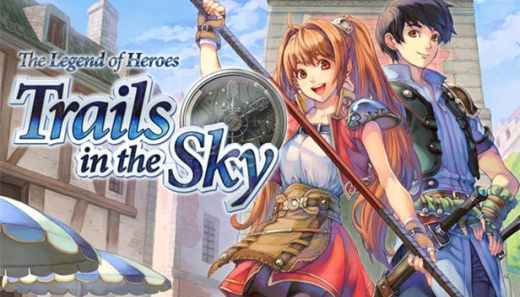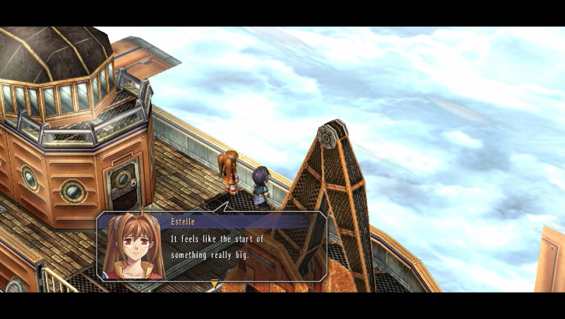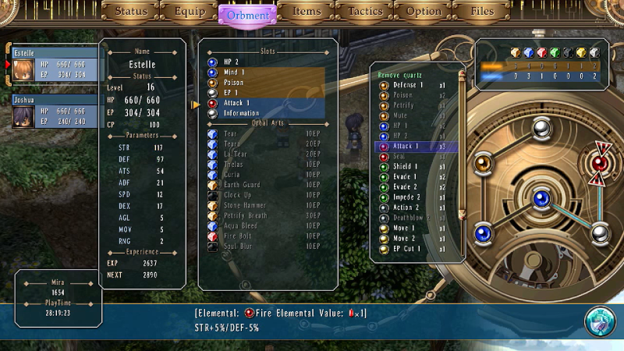
If you don’t like reading, this game may not be for you. If cutting-edge graphics are something you look for in an RPG… go play Final Fantasy XV. But if what you do value in RPGs includes world building, character development, intriguing plots, and the some of the best writing in the video game industry, you owe it to yourself to play The Legend of Heroes: Trails in the Sky FC.
The Legend of Heroes: Trails of… series (from here on referred to as “Trails”), while not particularly well known in the west, is one of the best JRPG series going right now. The key characteristic that makes this series stand out is its unrivaled continuity. This isn’t like most RPG series where every one-to-two games sees a full reboot with entirely new characters and an entirely new world. The Trails games, which have so far played out over nine games split into three major story arcs beginning with the Sky trilogy, all take place in various countries throughout the continent of Zemuria, and share an overarching plot that was planned from the beginning. Through the most recent game, The Legend of Heroes: Trails of Cold Steel IV (released in 2018 in Japan), the series has moved forward five in-world years, and developer Nihon Falcom has said that they are 60% through the story they want to tell, meaning this series isn’t going to end any time soon.

All that continuity may sound impressive, but none of it means anything if the series doesn’t start off on a strong enough point to get you to care about any of it. And Falcom accomplishes that with the first entry in the series, The Legend of Heroes: Trails in the Sky First Chapter (from here on “FC”), as it is a great game in its own right.
The Sky trilogy takes place in a small but technologically-advanced kingdom called Liberl, 10 years removed from a failed invasion by the expansionist Erebonian empire. The game centers on two main protagonists, Estelle Bright and her adopted brother Joshua Bright, from the rural town of Rolent. At 16 years of age they have become old enough to join the Bracer Guild, a non-governmental organization with branches throughout the continent whose primary mission is to protect and help ordinary citizens in need, as junior bracers. Initially spurred on by the disappearance of an airship containing their father and other citizens of Rolent, the plot follows Estelle and Joshua as they tour the kingdom to find their father and also receive the qualifications to become full members of the guild. Each chapter places the protagonists in one of the kingdom’s major cities as they become familiar with the surrounding region and work to solve some mystery currently plaguing it, all the while slowly stumbling onto a much larger conspiracy that threatens the kingdom as a whole.

There are some who complain that Trails games are slow, that they’re bloated with text and the plot takes too long to get exciting. I couldn’t disagree more. Where others say the pace is slow, I call it deliberate. Much of the game works to establish and flesh out the world, and introduce its many characters and plotlines, all for it to come together in the end for a truly epic finale, made all the more meaningful by the groundwork that had been laid to that point. The game is filled to the brim with charming dialogue and character moments. It may be slow-moving, but it’s only to the game’s benefit. Still, this kind of pace may not be for everyone.
One of the areas FC shines the brightest is through its characters. In a genre plagued by generic main characters Estelle Bright is a breath of fresh air. Something of a tomboy (though don’t call her that or she’ll threaten to whack you in the head with her staff), she loves the outdoors, doesn’t have the patience for classroom learning and has a tendency to act before thinking. She also has a bright (pun intended?) personality that instantly lifts any room she enters. You can tell Xseed, the translation company behind bringing this game into English, had a blast writing every one of her lines. Joshua, her adopted brother and the game’s secondary main character, serves as a perfect foil. Unlike Estelle he is calm and collected, and his booksmarts and decision making skills help round out her weak points. Their chemistry is palpable, and they bring out the best traits in each other. Throughout the journey you’ll also meet plenty of other colorful and interesting characters complete with their own character arcs, and no party member ever feels like excess baggage.

In what is perhaps the Trails series’ best trait, the attention to detail in the world runs deep. Nearly every NPC in the game has a name and a life, complete with relationships with other NPCs. Their dialogue changes after every story event, so if you wish you can talk to the NPCs regularly to read their dialogue (which there is a LOT of), and even pick up some tidbits about the world and plot you would have missed otherwise. NPCs will often even have full-on conversations with your party members, especially in the main characters’ hometown of Rolent, because of course they would have a conversation, they’ve known each other for years. You can even read a newspaper called the Liberl News that is published about twice a chapter to read about events of national and international importance and also learn about leisure and cuisine spots throughout the country. Sidequests also serve to flesh out the world and deepen your characters’ connections to the kingdom’s various regions.
But enough about characters and plot; how does the game actually play? The combat is an entirely turn-based system that plays out on a grid-based battle arena. Your characters (of which you can have up to four in battle at a time) have a certain number of spaces they can move each turn, and an attack range that depends on their weapon. The turn order plays out Final Fantasy X style, allowing you see who will move for the next 5-10 turns in advance. You are shown when certain turn bonuses will appear, such as a guaranteed critical hit or a 10% HP recovery, giving you incentive to manipulate the turn order to the best of your ability. You can do this in a number of ways including using moves that delay your enemies, speed up your allies, or by using a special move that can interrupt the turn order at any point. You need to pay attention to those bonuses, as being negligent can result in some nasty situations.

Your characters have three methods of dealing damage: physical attacks, arts, and crafts. Arts are your standard JRPG magic – they can be used to attack and also to buff your allies, and require EP to cast. Higher level arts typically affect a wider range of the battle field, allowing you to attack multiple enemies at once. One of my criticisms of this game and the Sky trilogy as a whole is that low level and high level arts do about the same damage. It’s a bizarre decision that completely disincentivizes you from casting arts with a higher EP cost unless you are fighting a horde of enemies and wish to hit multiple of them at once.
Crafts are moves unique to each character and require CP, a meter that is built up by dealing and receiving damage. Your party members get anywhere from two to six crafts throughout the adventure. Crafts can perform a wide variety of functions including attacking multiple enemies, giving you a chance of inflicting an enemy with a status ailment or a turn delay, healing or buffing your party members, and so on. Unlike arts, crafts can be used immediately, provided you have enough CP. Each character also gets one or two S-crafts, which are special moves that exhaust all of your CP and can be unleashed at any time regardless of turn order. You can only use S-crafts if you have 100 CP or more, which results in you constantly having to strike a balance between using your normal crafts or saving up for the potentially tide-turning S-craft. The craft system is a brilliant addition that makes each character feel distinct and fun to use.
Accompanying the battle system is a simple yet deep customization system that makes use of devices called orbments. Orbments are made up of six slots into which you insert refined elemental crystals called “quartz”. Each quartz comes with an effect such as raising attack, or making it so each physical attack has a 10% of inflicting a status ailment. But there’s a catch: typically a quartz that raises a certain stat will also lower another stat. If you want higher attack, you’ll have to accept lower defense. This creates a game of give-and-take where you have to decide how much of one stat you’re willing to lower for the benefit of another.

There’s one more very important thing you have to think about when setting up your orbments: the elemental values of the quartz. Each quartz you equip gives you points toward an elemental value that when added up gives you access to arts. Some arts require a minimum amount of just one element, and others require a minimum amount of multiple elements. The powerful wind art Aerial, for example, requires at least four wind value, whereas the game’s revive art requires a combination of at least four water, two earth, and one mirage. This is where you have to pay attention to the color-coded lines, as the arts you receive are determined by the elemental value built up on each individual line. All of the game’s arts are listed within an in-game manual that is easily accessible with the press of a button, even while you are within the orbment menu, but the constant checking of the manual when configuring your orbment could get annoying for some. Fortunately the game does let you know instantly in the orbment menu what arts you will obtain from each quartz placement.
While this system is flexible, you can’t just do whatever you want with any character. Each orbment comes in a different shape; some characters have three or four shorter lines, making it difficult for them to obtain higher level arts, whereas other characters have only one long line, setting them up to be used as a caster. But having more, shorter lines doesn’t make your orbment useless; it just means you have to prioritize other things, such as boosting stats. The result is a system where characters are customizable but not blank slates; you have the freedom to adjust characters to try to fit the role you want, but their base stats, crafts, and orbment shape encourage you to use them a certain way.
Originally released in 2004 for the PC, FC isn’t going to blow you away graphically, but its presentation has aged well. The game plays out in a top-down perspective in 3D environments, with 2D character sprites made to look like quasi-chibi 3D models. The 3D environments look nice considering the age of the game, though some textures do clearly look dated. Each of the game’s five major cities are distinct and fun to explore. It is unfortunate though that in a game called Trails in the “Sky”, you can’t ever actually look up and see the sky, as you can’t move the camera out of its top-down view.

The models lack facial animation but the game makes up for it with its wonderfully expressive dialogue portraits. There are around 50 characters in the game that are given portraits, and each one perfectly captures their personality. Main characters Estelle and Joshua each have 20+ different facial expressions, and their portrait count is more than tripled if you count wardrobe and hair changes. Considering the volume and variety of expressions, these may be the best and most well-drawn portraits I’ve seen in a JRPG.
The music is classic JRPG goodness, bound to fill you with a sense of both adventure and nostalgia. The regular battle theme is a standout, eschewing your typical JRPG battle sound for a more laid back jazz approach. It will catch you off guard at first but it’s unique in an area where many RPGs aren’t, and it perfectly complements the game’s battle system (it helps that it’s also ridiculously catchy). The town themes are effective at helping to build a distinct atmosphere in each area, whether it’s giving the rural town of Rolent a peaceful acoustic guitar and piano arrangement, or supplying a tropical choir-imbued theme for the seaside city of Ruan. The music can sound very obviously MIDI in places, but the soundtrack has so much character it really only adds to the charm.
In conclusion, Trails in the Sky First Chapter is a fantastic game that deserves to be more well known than it is. It’s not a perfect game. Battles are slow moving with animations that drag out slightly too long, and it lacks any kind of fast travel system (though the addition of turbo in the PC version alleviates both of these issues). It is not a difficult game; battles don’t really become all that challenging until the second Sky game, and especially the third. There’s some graphical awkwardness in the PC version on the edges of the screen which were not visible in the original game but were exposed through the upgrade to widescreen. The music is great, but the song choice doesn’t always quite match the mood the situation calls for. But these issues are minor, and with its story, characters, world, battle system, music, and more it stands tall among the best of the JRPG genre. It may be the beginning of a trilogy, and the start of something much larger, but there is no need to fear FC not feeling like a complete experience. This game is a downright classic that any JRPG fan should make an effort to play.
9/10
